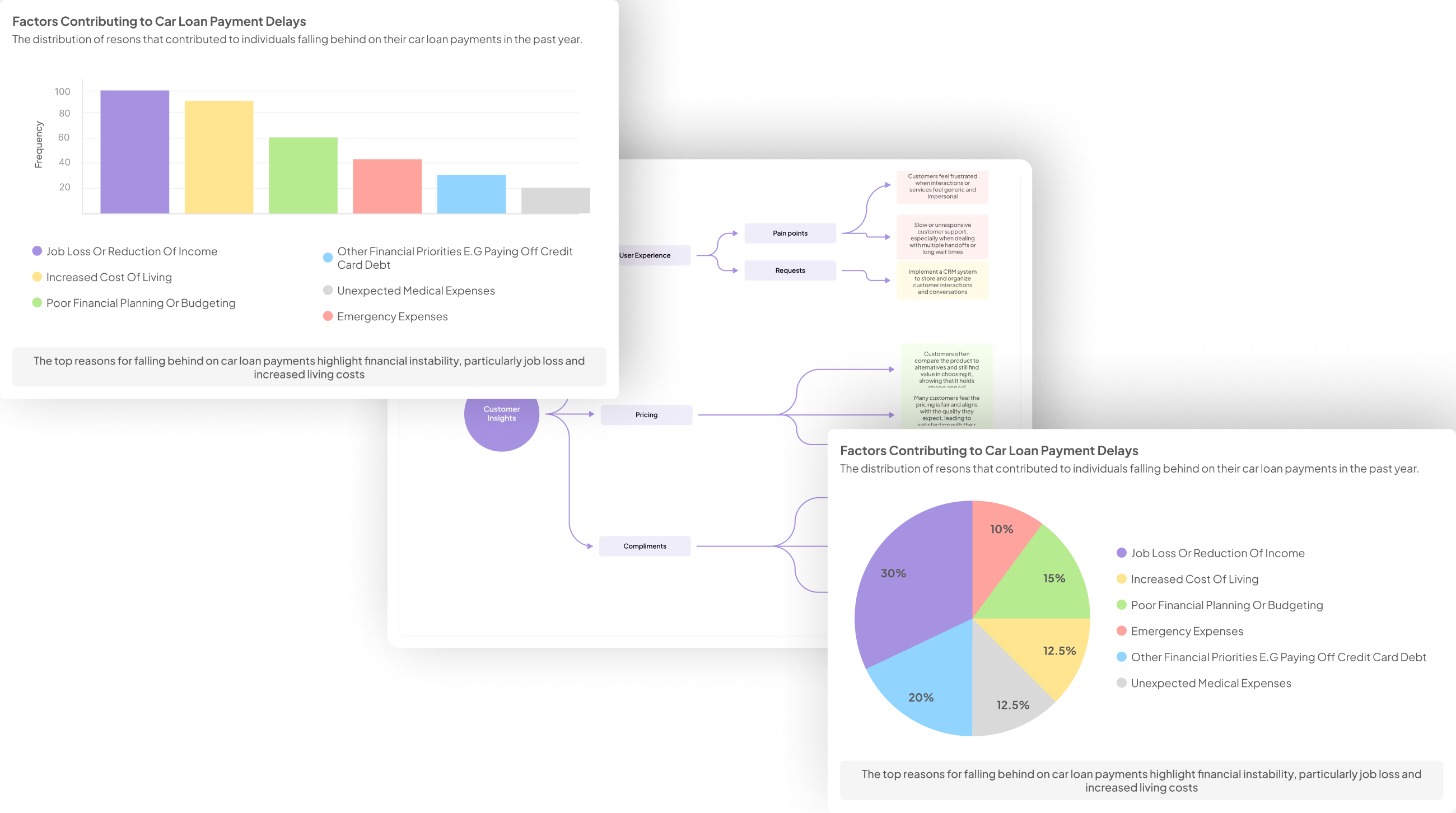Empowered Text Analytics: Practical Guide
-
Bella Williams
- 10 min read
Advanced Text Interpretation is the gateway to unlocking deeper insights from textual data in today's information-rich environment. As organizations sift through vast amounts of unstructured text, effective interpretation techniques become critical for making informed decisions. This section introduces key concepts and methods, empowering you to harness the full potential of text analytics.
Understanding how to analyze conversations and extract valuable insights can raise your organization's strategic edge. From synthesizing customer interactions to identifying trends, advanced text interpretation makes it easier to derive meaningful patterns. By employing cutting-edge tools and methodologies, you can enhance data comprehension and improve overall outcomes within your analytical processes.
Generate visualizations from your qualitative data. At Scale.

Exploring Advanced Text Interpretation Techniques
Advanced Text Interpretation techniques play a pivotal role in modern text analytics by enhancing our ability to glean insights from vast datasets. These methods go beyond simple keyword recognition or summarization; they involve sophisticated algorithms and models that interpret context, sentiment, and intent within text. This empowers users to analyze social media conversations, customer feedback, or product reviews more effectively. The focus here is on how advanced techniques can streamline the interpretation process and provide actionable insights.
Consider techniques such as Semantic Analysis, which interprets the meanings behind words, and Sentiment Analysis, which gauges emotional tones in textual data. These approaches help businesses understand customer sentiment and preferences quickly. Additionally, employing machine learning models allows for continual learning and adaptation, improving analysis precision over time. By integrating these advanced text interpretation techniques into your analytics strategy, you can transform raw textual data into valuable information that informs decisions and drives success.
Understanding the Basics of Text Analytics
Text analytics serves as a foundational element in extracting meaningful information from unstructured data. By applying various techniques, one can convert raw text into actionable insights that benefit decision-making processes. Understanding the basics involves grasping how text data is processed, analyzed, and interpreted. It's essential to recognize the role of natural language processing, which allows systems to comprehend human language patterns, thus paving the way for advanced text interpretation.
To harness the power of text analytics effectively, consider the following key components:
Data Collection: Accumulate the necessary text data from various sources, ensuring that it is relevant and diverse to enhance analysis.
Text Processing: Clean and prepare the text for analysis by removing noise, standardizing formats, and normalizing data for consistency.
Analysis Techniques: Use methods such as sentiment analysis and topic modeling to derive deeper insights from the text data at hand.
Each of these aspects contributes to a more robust understanding of text analytics, underscoring the importance of a methodical approach in leveraging its power for advanced text interpretation.
Leveraging Natural Language Processing for Deeper Insights
Natural Language Processing (NLP) transforms raw text data into actionable insights by systematically analyzing language patterns. By employing NLP techniques, organizations can unveil hidden sentiments, trends, and topics within vast text datasets, thereby enhancing business decision-making. The ability to extract meaningful information directly from customer interactions, such as interviews and feedback, contributes significantly to advanced text interpretation.
Utilizing NLP not only streamlines the data analysis process but also ensures deeper insights are reached more efficiently. With advanced algorithms, businesses can identify customer needs, preferences, and sentiments in real time. This leads to improved product offerings and personalized customer experiences. Furthermore, NLP supports the aggregation of insights from various communication sources, enabling teams to collaborate effectively and develop strategic responses that resonate with their target audience. Employing NLP allows organizations to harness the full potential of customer conversations, turning feedback into a valuable resource for growth.
Practical Steps to Implement Empowered Text Analytics
To implement empowered text analytics effectively, organizations must first focus on data collection and preprocessing. Collecting relevant data from various sources, such as customer feedback, social media, and internal communications, provides a solid foundation for analysis. Once data is gathered, preprocessing ensures that it is clean and structured, enhancing accuracy during analysis. This step often involves removing duplicates, fixing inconsistencies, and standardizing formats, which increases the effectiveness of advanced text interpretation.
Next, selecting and training the appropriate models is crucial. Organizations should explore various machine learning techniques tailored to their specific needs, such as sentiment analysis or topic modeling. Training these models on preprocessed data allows them to learn nuanced patterns and improve their predictive capabilities. Continuous evaluation and refinement of these models ensure they adapt to evolving data trends. By following these practical steps, businesses can harness empowered text analytics to generate actionable insights and drive strategic decision-making.
Evaluate Performance on Customer Calls for Quality Assurance.
Step 1: Data Collection and Preprocessing
Data collection and preprocessing serve as foundational steps in the journey toward advanced text interpretation. First, gather diverse data sources, which can include customer feedback, support tickets, social media posts, and survey responses. This range ensures a comprehensive perspective, contributing to the richness of insights derived later.
Once the data is collected, preprocessing is essential for refining it. This stage involves cleaning the data by removing irrelevant content, correcting errors, and standardizing formats. Additionally, applying techniques such as tokenization and stemming can enhance the analysis, making it easier to extract meaningful patterns. By carefully preparing your data, you set the stage for effective analysis, ultimately leading to deeper insights that drive actionable strategies. The value of this meticulous groundwork cannot be overstated. It directly influences the quality of analysis outcomes, supporting your objectives in advanced text interpretation.
Step 2: Model Selection and Training
Selecting the right model for text analytics is crucial for achieving advanced text interpretation. You need to understand various algorithm options tailored to your specific data and objectives. Start by evaluating the complexity of your text data and the insights you aim to gain. Popular models, like logistic regression or more complex neural networks, offer distinct advantages depending on your use case. An understanding of your data's nuances can guide your choice effectively.
Once a model is selected, the training process becomes essential. Carefully partition your data into training and validation sets to ensure your model generalizes well. Use a variety of metrics to assess the model's performance, such as accuracy and F1 score. It’s prudent to iterate through model adjustments based on these metrics until optimal results are achieved. This phase enables you to transform raw text data into meaningful insights, enhancing decision-making and overall analysis capabilities.
Conclusion: Mastering Advanced Text Interpretation
Mastering advanced text interpretation is essential for transforming complex linguistic data into actionable insights. This process requires a blend of skills, from data handling to analytical thinking, enabling users to decipher intricate patterns within text. As we conclude this exploration, it is crucial to recognize that effective interpretation can significantly impact decision-making in various fields.
Incorporating these advanced techniques allows individuals to extract meaningful information from vast datasets. This understanding supports better customer engagement and drives innovation within organizations. Ultimately, mastering advanced text interpretation empowers professionals to harness the wealth of knowledge contained in human language.







